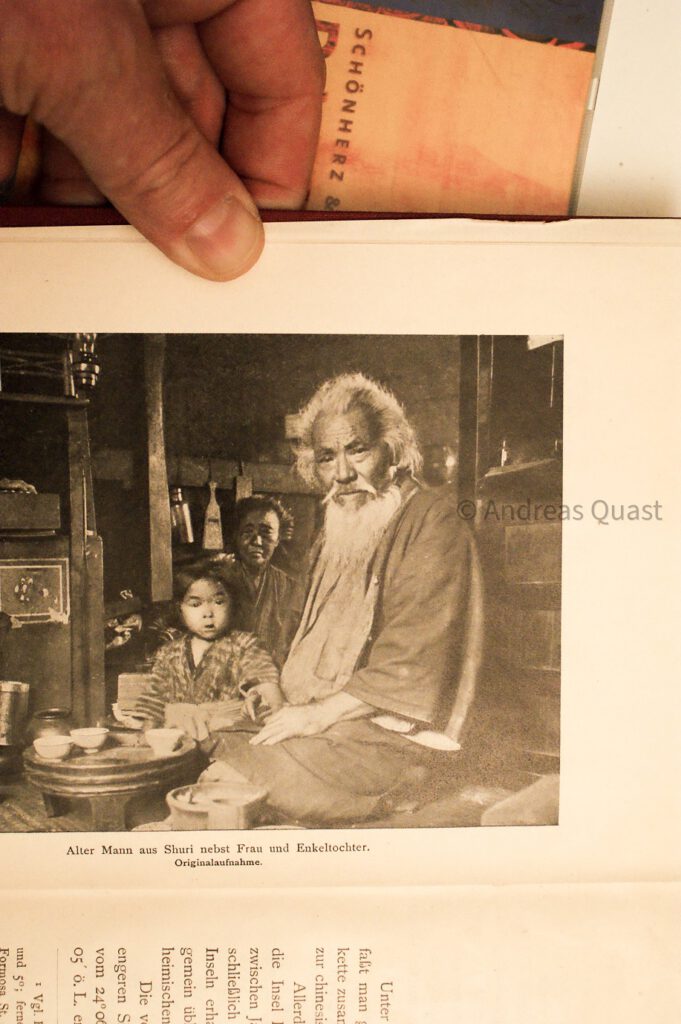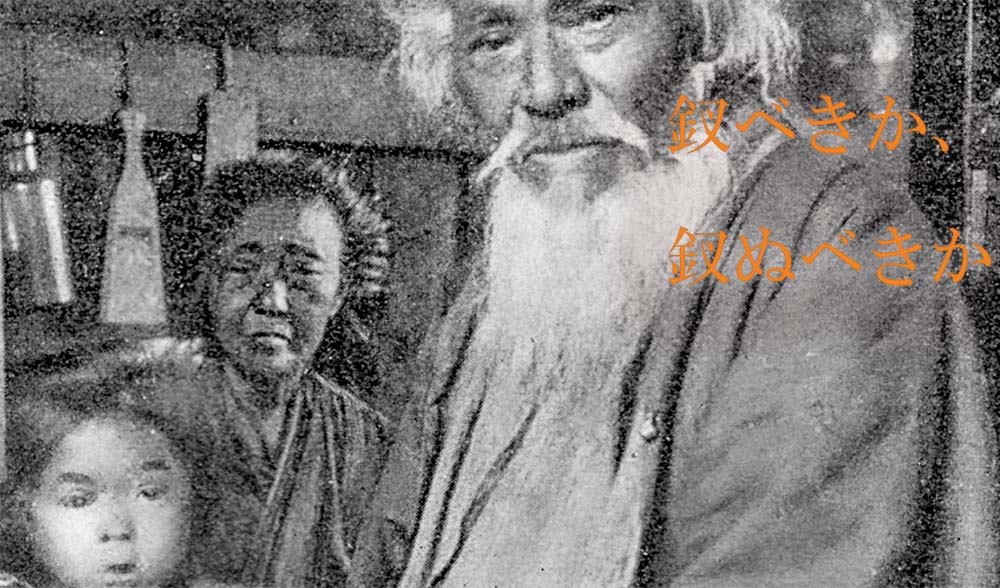In 2015 I wrote an article about the photo considered to show Kinjo Ufuchiku. In short, the original photo was taken by Edmund M. H. Simon in Okinawa in 1910. Here I will look at the copies of the photo discovered in Okinawa, and how they might have gotten there.
Simon studied law and philosophy at the Universities of Tübingen and Berlin. He also studied Japanese in Berlin. After passing his exam in 1908, he was appointed official interpreter at the German Embassy in Tokyo. In 1909 he was appointed Consul for Kobe and Nagasaki. He left Japan for Europe in late 1910 and also ended his diplomatic service. He devoted himself to writing and returned to Nagasaki in 1911 to work as a teacher of the German language at the Nagasaki Business School.
The photo of Kinjo Ufuchiku is found in this inaugural dissertation as a Doctor of Law at the Royal University of Leipzig in 1912, and published in 1913.

SONY DSC
EN “Old man from Shuri with his wife and granddaughter. Original photo.”
Kinjo Ufuchiku is an important person in Okinawa karate kobudo history. This is because he bridged old Ryukyu with early modern Okinawa, which means that his personal instruction inherited old techniques to the new era. For instance, he is found in the genealogy of Taira-lineage kobudo, which was prepared around the 1970s. He is also found in what is called Ufuchiku-Tradition (Ufuchiku-den).
Due to his importance for the transmission of original techniques, when the old photo was rediscovered around the 1980s,by karate kobudo practitioners, it was a sensation. However, at that time (and I think until now) none of them made a connection to Edmund Simon’s book.
First, Nakamoto Masahiro of Bunbukan discovered the photo in the 1980s. Subsequently he described it in a newspaper article and in his books. At that time, Nakamoto Sensei said that he visited the descendant of Kinjo several times, and finally discovered the photo. The descendant was most likely the granddaughter. According to Nakamoto Sensei, she had a copy of the original photo that was owned by a British person. Nakamoto Sensei only presented a cutout of the full photo.
Second, according to eyewitness testimony, Isa Kaishu of the Ufuchiku-Tradition had the full photo in his photo album. Also, the little girl in the photo, who is the granddaughter, identified the man as her grandfather Kinjo Ufuchiku.
In short, Nakamoto Sensei referred to the photo owned by the granddaughter of Kinjo Ufuchiku, who is in the photo, and who also identified the old man as Kinjo Ufuchiku.
As regards the photo’s origin, Isa Kaishu remained silent about any particulars where his copy came from, Kinjo’s granddaughter, the book, or elsewhere. Since no information is provided, people will make the easiest connection and believe that the photo was a family heritage.
According to Nakamoto Sensei however, the photo was a copy of an original photo, and this copy was owned by a British person. The original photo – as described in the caption of Simon’s thesis – was made by Simon in 1910. Therefore, there are a bunch of possibilities here.
For instance, the British person said to have owned a copy of the original photo might have simply owned the book by Simon. And the descendants or Nakamoto Sensei took the photo from that book. This is actually the most obvious explanation. Sometimes book sellers also cut photo pages aout of books, frame them, and sell them at high prices. Or, Kinjo’s family might have received a copy of Simon’s original photo back in 1910, that is, if the photo was developed in Okinawa, or later, after Simon returned to Nagasaki. Also, the photo might have been developed several times, so there were several originals. Moreover, Simon might have shared the negative. This would all assume that Kinjo’s house and belongings in Shuri were not destroyed during the war. If house and belongings were destroyed, the copy of the photo or otherwise the book by Simon must have reached Kinjo’s descendant only in the postwar era. Unfortunately, such details were not shared, leaving vast grounds for speculation.
In any case, if it is really Kinjo, and I guess chances are good, it is an amazing photo which provides a visual of an important person in the history and technique of karate kobudo.
BTW, there is the question of what Kinjo actually taught. In the Taira-lineage kobudo, it is only said that he taught saijutsu. The same is said in the tradition of Kina Shosei. As regards credibility, both of these have a certain weight.
However, Isa Kaishu, who has learned methods such as tuite in the postwar era, also teaches empty-handed techniques under the umbrella term of “Ufuchiku-Tradition.”
Such contradictions are characteristic for Okinawan martial arts and I might write a book about in one day.
© 2023, Andreas Quast. All rights reserved.

